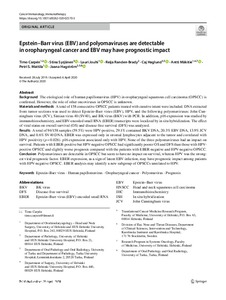Epstein-Barr virus (EBV) and polyomaviruses are detectable in oropharyngeal cancer and EBV may have prognostic impact
Timo Carpén; Stina Syrjänen; Lauri Jouhi; Reija Randen‑Brady; Caj Haglund; Antti Mäkitie; Petri S. Mattila; Jaana Hagström
https://urn.fi/URN:NBN:fi-fe2021042822226
Tiivistelmä
Background The etiological role of human papillomavirus (HPV) in oropharyngeal squamous cell carcinoma (OPSCC) is confirmed. However, the role of other oncoviruses in OPSCC is unknown.
Materials and methods A total of 158 consecutive OPSCC patients treated with curative intent were included. DNA extracted from tumor sections was used to detect Epstein-Barr virus (EBV), HPV, and the following polyomaviruses: John Cunningham virus (JCV), Simian virus 40 (SV40), and BK virus (BKV) with PCR. In addition, p16 expression was studied by immunohistochemistry, and EBV-encoded small RNA (EBER) transcripts were localized by in situ hybridization. The effect of viral status on overall survival (OS) and disease-free survival (DFS) was analyzed.
Results A total of 94/158 samples (59.5%) were HPV-positive, 29.1% contained BKV DNA, 20.3% EBV DNA, 13.9% JCV DNA, and 0.6% SV40 DNA. EBER was expressed only in stromal lymphocytes adjacent to the tumor and correlated with HPV positivity (p = 0.026). p16 expression associated only with HPV. None of the three polyomaviruses had an impact on survival. Patients with EBER-positive but HPV-negative OPSCC had significantly poorer OS and DFS than those with HPV-positive OPSCC and slightly worse prognosis compared with the patients with EBER-negative and HPV-negative OPSCC.
Conclusion Polyomaviruses are detectable in OPSCC but seem to have no impact on survival, whereas HPV was the strongest viral prognostic factor. EBER expression, as a sign of latent EBV infection, may have prognostic impact among patients with HPV-negative OPSCC. EBER analysis may identify a new subgroup of OPSCCs unrelated to HPV.
Kokoelmat
- Rinnakkaistallenteet [27094]
